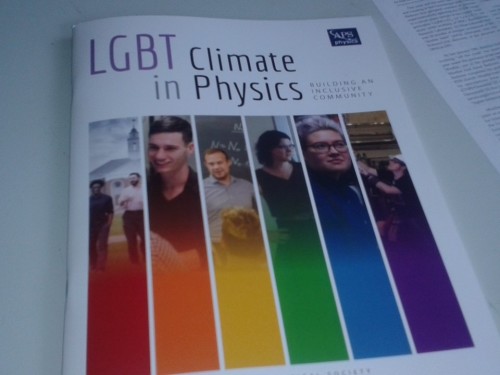
Lifting the lid: the LGBT Climate in Physics report launched at the APS March meeting.
By Matin Durrani in Baltimore, Maryland, US
I’ve been thinking a lot recently about the make-up of the physics community, particularly as this month saw Physics World publish a special issue, “Physics for all: building a more inclusive discipline”, that examined ways to make physics as welcoming as possible for everyone. It looked, for example, at “microaggressions” in physics, the role of unconscious bias and whether physics is just for people from better socioeconomic backgrounds.
One article that attracted particular attention – based on informal feedback and e-mails I’ve received since the issue came out – was “Where people and particles collide”. Written by my Physics World colleague Louise Mayor, it looks at what life’s like for gender and sexual minorities at the CERN particle-physics lab in Geneva and the challenges people there faced in setting up an official LGBT Cern Club. (There is still no such club, but CERN has set up an LGBT “informal network”.)
The issues facing gender and sexual minorities have also been a theme here at the APS March meeting, with the launch this morning of a new APS report LGBT Climate in Physics. The report is based on focus groups, a “climate survey” of more than 320 members of the US LGBT physics community, and follow-up interviews with five survey participants. A further 2596 members of the entire APS community replied to a separate survey, of whom 2.5% identified themselves as LGBT.
The report was instigated in 2014 by Kate Kirby, executive officer of the APS, who created an ad hoc committee on LGBT issues – chaired by Michael Falk of Johns Hopkins University – that has spent the last 18 months investigating the topic. It’s great to see the APS commissioning the report, even if it revealed a mixed picture for LGBT physicists, with experiences varying greatly depending on where respondents are based. “The situation is uneven from country to country and state to state and from university to university,” says Falk.
For me, one finding stood out, which is that fully one-third of respondents have considered quitting their workplace or university in the last year. There was some good news in that half of all respondents to the climate survey say campus or workplace policies for them are “highly supportive” or “supportive”. On the other hand, almost a third (30%) say those policies are “uneven”, “lacking” or “discriminatory” – a figure rising to 49% for transgender respondents. Meanwhile, 44% of women say they’ve experienced harassment, compared with 31% for men.
One big problem is that many LGBT physicists feel isolated and many have trouble identifying “allies”, who may or may not be LGBT but who could help, mentor or guide them with exclusion. “If things are going to change, they’re going to change because physicists on the ground want it to,” says Falk.
I hope this report acts as a stimulus for that change.
Guidelines
Show/hide formatting guidelines
this text was deletedwhere people live in harmony with nature and animals</q>
Some text